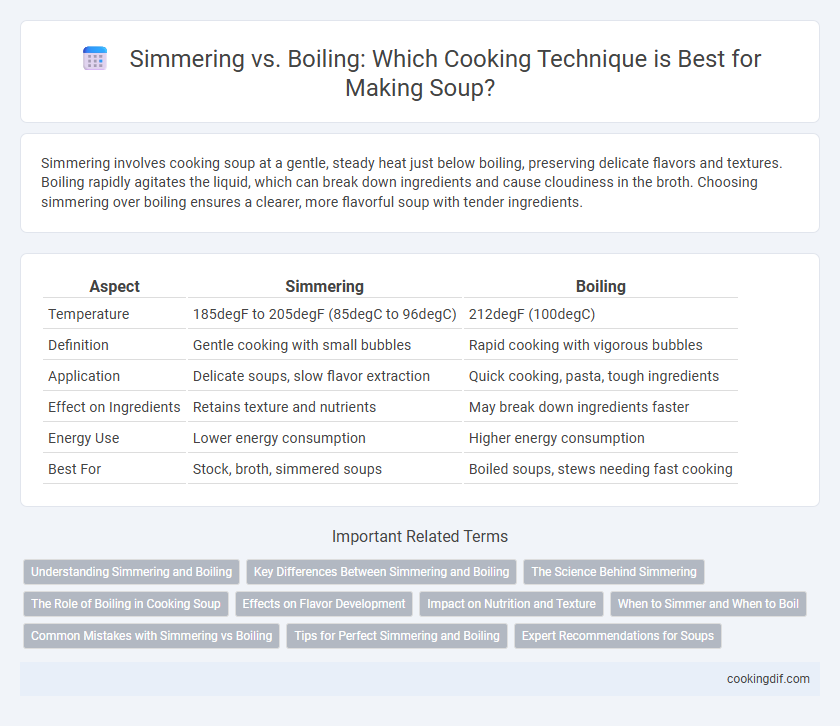Simmering involves cooking soup at a gentle, steady heat just below boiling, preserving delicate flavors and textures. Boiling rapidly agitates the liquid, which can break down ingredients and cause cloudiness in the broth. Choosing simmering over boiling ensures a clearer, more flavorful soup with tender ingredients.
Table of Comparison
| Aspect | Simmering | Boiling |
|---|---|---|
| Temperature | 185degF to 205degF (85degC to 96degC) | 212degF (100degC) |
| Definition | Gentle cooking with small bubbles | Rapid cooking with vigorous bubbles |
| Application | Delicate soups, slow flavor extraction | Quick cooking, pasta, tough ingredients |
| Effect on Ingredients | Retains texture and nutrients | May break down ingredients faster |
| Energy Use | Lower energy consumption | Higher energy consumption |
| Best For | Stock, broth, simmered soups | Boiled soups, stews needing fast cooking |
Understanding Simmering and Boiling
Simmering maintains liquid temperature just below boiling point, typically around 185-205degF (85-96degC), allowing gentle cooking that preserves delicate flavors and prevents food from breaking apart. Boiling occurs at 212degF (100degC), causing vigorous bubbling that accelerates cooking but can toughen ingredients and dilute flavors in soups. Choosing simmering over boiling ensures better texture and enhanced taste in slow-cooked dishes like broths and stews.
Key Differences Between Simmering and Boiling
Simmering involves cooking liquid at a temperature between 185degF and 205degF, producing gentle bubbles, which helps preserve delicate flavors and textures in soups. Boiling occurs at 212degF, creating vigorous bubbles that rapidly cook ingredients but can break down textures and dilute flavors more quickly. Choosing simmering over boiling ensures better control over the soup's consistency and prevents overcooking or loss of aroma.
The Science Behind Simmering
Simmering maintains a liquid temperature between 185degF and 205degF, allowing gentle bubbles to form without vigorous agitation, which preserves the delicate flavors and textures in soups. This controlled heat ensures that proteins and starches coagulate gradually, enhancing the breakdown of ingredients and deepening flavor profiles without overcooking or toughening components. Unlike boiling at 212degF, simmering minimizes evaporation and prevents the emulsification of fats, resulting in a clearer, more balanced broth.
The Role of Boiling in Cooking Soup
Boiling in cooking soup rapidly heats the liquid to 212degF (100degC), ensuring thorough cooking of ingredients and the elimination of harmful bacteria. This intense heat accelerates the breakdown of tougher vegetables and meat, enriching the soup's flavor and texture. Maintaining a rolling boil is essential for achieving the desired consistency and safety in many soup recipes.
Effects on Flavor Development
Simmering soup allows flavors to develop more fully as gentle heat encourages gradual extraction and blending of ingredients, preserving delicate aromas and subtle taste nuances. Boiling, with its higher temperature and vigorous bubbles, can cause harsh flavors to emerge and may break down sensitive components, resulting in a less balanced and muddled taste. Controlled simmering enhances complexity and depth in soups, ensuring optimal flavor profile without compromising ingredient integrity.
Impact on Nutrition and Texture
Simmering soup at a lower temperature preserves delicate nutrients such as vitamins B and C, which are sensitive to intense heat, while maintaining a tender, well-blended texture. Boiling can accelerate nutrient loss and break down ingredients too rapidly, resulting in a less desirable, mushy consistency. Choosing simmering over boiling enhances both the nutritional value and mouthfeel of the final dish.
When to Simmer and When to Boil
Simmering is ideal for delicate ingredients like vegetables, beans, or meats that require gentle cooking to retain texture and develop flavors without breaking apart. Boiling is best for rapidly cooking pasta, grains, or blanching vegetables, where high temperatures quickly soften food or kill bacteria. Use simmering for slow-cooked soups and stews to deepen flavors, while boiling suits recipes needing fast cooking or sterilization.
Common Mistakes with Simmering vs Boiling
Common mistakes when simmering versus boiling soup include overheating the pot, which causes boiling instead of a gentle simmer, leading to tough meats and cloudy broth. Many cooks fail to adjust the heat properly, resulting in rapid boiling that breaks down delicate ingredients and evaporates too much liquid. Maintaining a consistent simmer between 185degF and 205degF preserves flavors and texture, avoiding the loss of nutrients and unwanted bitterness.
Tips for Perfect Simmering and Boiling
Maintain a consistent low heat to achieve perfect simmering, where small bubbles gently rise without breaking the surface, preserving delicate flavors and textures in soups. Use a heavy-bottomed pot to distribute heat evenly and prevent scorching, adjusting the heat to avoid rapid boiling, which can cause ingredients to break down prematurely. Stir occasionally and skim off foam to keep the broth clear, ensuring a rich and flavorful soup.
Expert Recommendations for Soups
Expert recommendations for soup cooking emphasize simmering over boiling to preserve delicate flavors and prevent ingredients from breaking down. Simmering at gentle, low heat allows ingredients like vegetables and proteins to infuse the broth without becoming mushy. Boiling, conversely, can cause rapid evaporation and a harsher taste, reducing the soup's overall quality and texture.
Simmering vs Boiling for cooking technique Infographic

 cookingdif.com
cookingdif.com